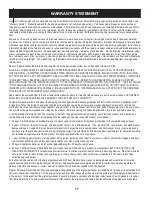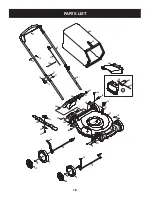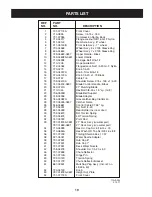
4
SAFETY INSTRUCTIONS
The blade control handle is a safety device. Never attempt to
•
bypass its operation. Doing so makes the safety device inopera-
tive and may result in personal injury through contact with the
rotating blade. The blade control handle must operate easily
in both directions and automatically return to the disengaged
position when released.
Never operate the mower in wet grass. Always be sure of your
•
footing. A slip and fall can cause serious personal injury. If you
feel you are losing your footing, release the blade control handle
immediately and the blade will stop rotating within three seconds.
Mow only in daylight or good artificial light. Walk, never run.
•
Stop the blade when crossing gravel drives, walks or roads.
•
If the equipment should start to vibrate abnormally, stop the
•
engine and check immediately for the cause. Vibration is gener-
ally a warning of trouble.
Shut the engine off and wait until the blade comes to a complete
•
stop before removing the grass catcher or unclogging the chute.
The cutting blade continues to rotate for a few seconds after the
blade control is released. Never place any part of the body in the
blade area until you are sure the blade has stopped rotating.
Never operate mower without proper trail shield, discharge cover,
•
grass catcher, blade control handle or other safety protective de-
vices in place and working. Never operate mower with damaged
safety devices. Failure to do so can result in personal injury.
Muffler and engine become hot and can cause a burn. Do not
•
touch.
Never attempt to make a wheel or cutting height adjustment while
•
the engine is running.
Only use parts and accessories made for this machine by the
•
manufacturer as listed in the Parts pages of this Operator’s
Manual. Failure to do so can result in personal injury.
When starting engine, pull cord slowly until resistance is felt, then
•
pull rapidly. Rapid retraction of starter cord (kickback) will pull
hand and arm toward engine faster than you can let go. Broken
bones, fractures, bruises or sprains could result.
If situations occur which are not covered in this manual, use care
•
and good judgement. Contact 1-800-4MY-HOME® for information
and assistance.
SlOpe OperATION
Slopes are a major factor related to slip and fall accidents, which can
result in severe injury. Operation on slopes requires extra caution. If
you feel uneasy on a slope, do not mow it. For your safety, use the
Slope Guide included as part of this manual to measure slopes before
operating this machine on a sloped or hilly area. If the slope is greater
than 15 degrees, do not mow it.
Do:
Mow across the face of slopes; never up and down. Exercise
•
extreme caution when changing direction on slopes.
Watch for holes, ruts, rocks, hidden objects, or bumps which can
•
cause you to slip or trip. Tall grass can hide obstacles.
Always be sure of your footing. A slip and fall can cause serious
•
personal injury. If you feel you are losing your balance, release
the blade control handle immediately and the blade will stop
rotating within three (3) seconds.
Do Not:
Do not mow near drop-offs, ditches or embankments, because
•
you could lose your footing or balance.
Do not mow slopes greater than 15 degrees as shown on the
•
slope guide.
Do not mow on wet grass. Unstable footing could cause slipping.
•
CHIlDreN
Tragic accidents can occur if the operator is not alert to the presence
of children. Children are often attracted to the mower and the mowing
activity. They do not understand the dangers. Never assume that
children will remain where you last saw them.
Keep children out of the mowing area and under watchful care of
•
a responsible adult other than the operator.
Be alert and turn mower off if a child enters the area.
•
Before and while moving backwards, look behind and down for
•
small children.
Use extreme care when approaching blind corners, doorways,
•
shrubs, trees, or other objects that may obscure your vision of a
child who may run into the mower.
Keep children away from hot or running engines. They can suffer
•
burns from a hot muffler.
Never allow children under 14 years of age to operate this
•
machine. Children 14 and over should read and understand the
instructions and safe operation practices in this manual and on
the machine and be trained and supervised by an adult.
SerVICe
Safe Handling Of Gasoline:
To avoid personal injury or property damage use extreme care
•
in handling gasoline. Gasoline is extremely flammable and the
vapors are explosive. Serious personal injury can occur when
gasoline is spilled on yourself or your clothes, which can ignite.
Wash your skin and change clothes immediately.
Use only an approved gasoline container.
•
Never fill containers inside a vehicle or on a truck or trailer bed
•
with a plastic liner. Always place containers on the ground away
from your vehicle before filling.
Remove gas-powered equipment from the truck or trailer and
•
refuel it on the ground. If this is not possible, then refuel such
equipment on a trailer with a portable container, rather than from
a gasoline dispenser nozzle.
Keep the nozzle in contact with the rim of the fuel tank or
•
container opening at all times until fueling is complete. Do not use
a nozzle lock-open device.





































